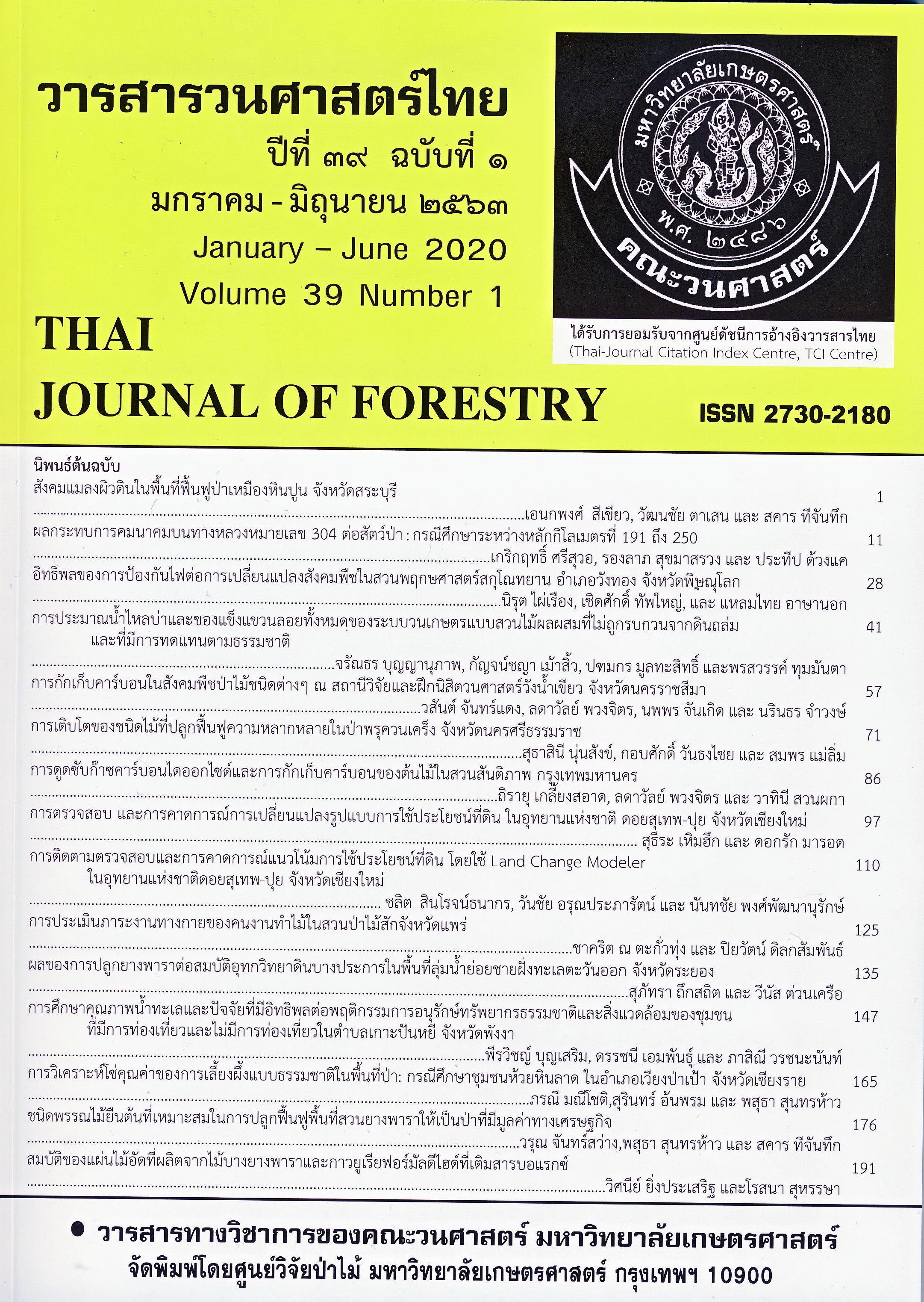ชนิดพรรณไม้ยืนต้นที่เหมาะสมในการปลูกฟื้นฟูพื้นที่สวนยางพาราให้เป็นป่าที่มีมูลค่าทางเศรษฐกิจ
Main Article Content
บทคัดย่อ
วัตถุประสงค์การวิจัยเพื่อศึกษาการเติบโตด้านเส้นผ่านศูนย์กลางที่ระดับคอรากผิวดิน ความสูงทั้งหมด ความเพิ่มพูนรายปีสัมพัทธ์ของชนิดพรรณไม้เศรษฐกิจ 10 ชนิด อายุ 5 ปี และศึกษาความเหมาะสมของชนิดพรรณไม้ในการปลูกเพื่อเปลี่ยนสวนยางพาราให้เป็นป่าที่มีมูลค่าทางเศรษฐกิจ โดยทำการคัดเลือกชนิดพรรณไม้เศรษฐกิจที่มีดัชนีค่าความสำคัญสูงสุด 10 อันดับแรกจากแปลงสาธิต ขนาด 40x40 เมตร จำนวน 2 แปลง ณ โครงการศูนย์เรียนรู้ป่าวังจันทร์ อำเภอวังจันทร์ จังหวัดระยอง จากนั้นสุ่มตัวอย่างแบบจำแนกชั้นภูมิตามชนิดพรรณไม้ที่รับคัดเลือกเพื่อเก็บข้อมูลขนาดเส้นผ่านศูนย์กลางที่ระดับคอรากผิวดิน ความสูงทั้งหมด และประเมินให้คะแนนตามความเหมาะสม 9 ปัจจัย วิเคราะห์ข้อมูลด้วยโปรแกรมสำเร็จรูปทางสถิติ และประเมินความเหมาะสมโดยวิธีการรวมแบบถ่วงน้ำหนักอย่างง่าย ทำการเก็บข้อมูลต่อเนื่องเป็นระยะเวลา 4 ปี ตั้งแต่ปี พ.ศ. 2559-2562
ผลการศึกษาพบว่า ชนิดพรรณไม้ที่มีขนาดความโตที่ระดับคอรากผิวดินมากที่สุดมี 2 ชนิด คือ ตะเคียนทอง (Hopea odorata Roxb.) และยางนา (Dipterocarpus alatus Roxb. ex G. Don.) ชนิดไม้ที่มีการเติบโตด้านความสูงทั้งหมดมากที่สุด คือ ประดู่ป่า (Pterocarpus macrocarpus Kurz.) ส่วนชะอมต้น (Archidendron conspicuum (Craib) I. C. Nielsen.) เป็นชนิดไม้ที่มีค่าเฉลี่ยความเพิ่มพูนรายปีสัมพัทธ์ทั้งด้านความโตและความสูงมากที่สุด และผลวิจัยในรอบ 4 ปีนี้สามารถสรุปได้ว่า ชนิดพรรณไม้ที่เหมาะสมในการปลูกเพื่อฟื้นฟูพื้นที่สวนยางพารา ได้แก่ ตะเคียนทอง พะยูง (Dalbergia cochinchinensis Pierre) ประดู่ป่า ยางนา กฤษณา (Aquilaria crassna Pierre ex Lecomte) ชะอมต้น เลือดแรด (Knema globularia (Lam.) Warb.) สาธร (Millettia xylocarpa Miq.) มะค่าโมง (Afzelia xylocarpa (Kurz) Craib) และ เคี่ยมคะนอง (Shorea henryana Pierre) มีค่าคะแนนความเหมาะสมเท่ากับร้อยละ 67, 62, 59, 57, 53, 52, 52, 51, 49 และ 38 ตามลำดับ
Downloads
Article Details
ข้าพเจ้าและผู้เขียนร่วม (ถ้ามี) ขอรับรองว่า ต้นฉบับที่เสนอมานี้ยังไม่เคยได้รับการตีพิมพ์และไม่ได้อยู่ในระหว่างกระบวนการพิจารณาตีพิมพ์ลงในวารสารหรือสิ่งตีพิมพ์อื่นใด ข้าพเจ้าและผู้เขียนร่วม (ถ้ามี) ยอมรับหลักเกณฑ์และเงื่อนไขการพิจารณาต้นฉบับ ทั้งยินยอมให้กองบรรณาธิการมีสิทธิ์พิจารณาและตรวจแก้ต้นฉบับได้ตามที่เห็นสมควร พร้อมนี้ขอมอบลิขสิทธิ์ผลงานที่ได้รับการตีพิมพ์ให้แก่วารสารวนศาสตร์ คณะวนศาสตร์ มหาวิทยาลัยเกษตรศาสตร์ กรณีมีการฟ้องร้องเรื่องการละเมิดลิขสิทธิ์เกี่ยวกับภาพ กราฟ ข้อความส่วนใดส่วนหนึ่ง หรือ ข้อคิดเห็นที่ปรากฏในผลงาน ให้เป็นความรับผิดชอบของข้าพเจ้าและผู้เขียนร่วม (ถ้ามี) แต่เพียงฝ่ายเดียว และหากข้าพเจ้าและผู้เขียนร่วม (ถ้ามี) ประสงค์ถอนบทความในระหว่างกระบวนการพิจารณาของทางวารสาร ข้าพเจ้าและผู้เขียนร่วม (ถ้ามี) ยินดีรับผิดชอบค่าใช้จ่ายทั้งหมดที่เกิดขึ้นในกระบวนการพิจารณาบทความนั้น”
เอกสารอ้างอิง
Jareanjiratrakun, S., P. Seusat. and I. Romyen. 2014. Economic Analysis in Increasing Green Space to the Rubber Plantation System (Complete Research Report). Faculty of Economic, Prince of Songkla University, Songkla.
Laboratory of Forest Indigenous Knowledge Management. 2018. Database on Economic Tree Species in Para Rubber Plantation. Faculty of Forestry, Kasetsart University, Bangkok. (in Thai)
Makmongkonchai, G. and N. Kannasut (eds.). 2015. Wangchan Forest Learning Center. Institute of Reforestation and Ecosystem, Bangkok.
Ministry of Natural Resources and Environment. 2018. MNRE control the Rubber Plantation of the Capitalist Group Wrong Laws. Available Source: http://www.mnre.go.th/th/news/detail/7288, October 20, 2018. (in Thai)
Nongdee, P. 2017. Valuation of Forest Carbon Model Wang chan Forest Project, Rayong Province in First Three Years. M.S. Thesis, Kasetsart University. (in Thai)
PTT Reforestation and Ecosystem Institute. 2015. Data Based of soil in Wang Chan Forest Center, Rayong Province. Available Source: http://www.pttreforestation.com/Researchview.cshtml?Id=7, August 20, 2019. (in Thai)
Royal Forest Department. 1993. Forest Planting: A Guide for Government Officials According to the Community Forest Development Project. Royal Forest Department, Bangkok. (in Thai)
Rubber Authority of Thailand. 2018. Rubber Database System. Available source: http://sc.raot.co.th/rdu/, August 24, 2018. (in Thai)
Rubber Research Institute of Thailand. 2015. Para Rubber Statistic. Available source: http://www. rubberthai.com/statistic, October 20, 2018. (in Thai)
Saravisutra, A. 2016. Multi-criteria decision making: comparison between SAW, AHP and TOPSIS concept and methods. Princess of Narathiwas University Journal 8(2): 180-192. (in Thai)
Sunthornhao, P. 2016. Forest carbon model, pp. 76-77. In P. Sunthornhao, ed. Eight Decades of The Science of the Land. Arksornsiam Printing, Bangkok.
Thai customs. 2019. Customs Department Announcement: Regarding the Determination of the Customs Value for Wood Products as an Evaluation Criteria for Export Duties. Available Source: http://www.customs.go.th/data_files/2faed6d1989e8139650cf7613cfc2c7c.pdf, July 31, 2019. (in Thai)
The Forest Herbarium. 2014. Tree Species Name of Thailand (Version 2014). Office of the Forest Herbarium. Department of National Parks, Wildlife and Plant Conservation, Bangkok.


